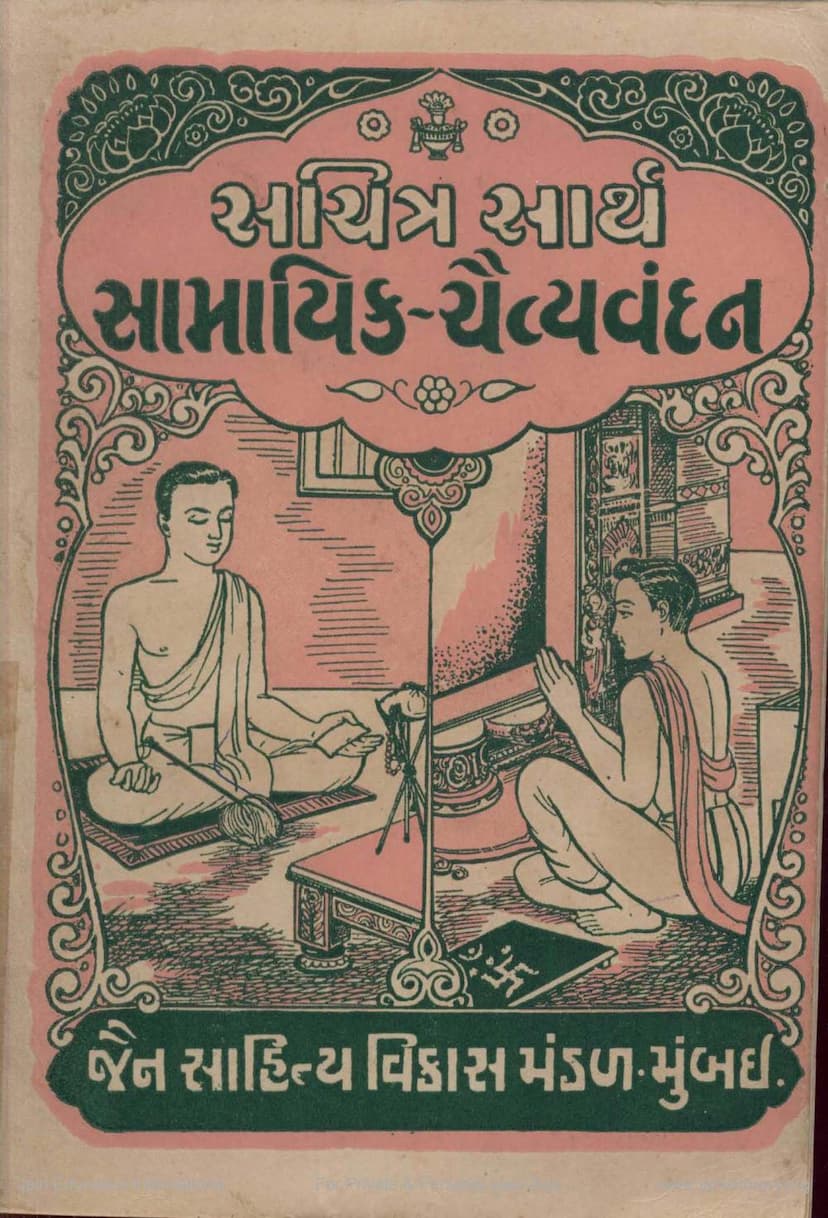Sachitra Sarth Samayika Chaityavandan
Added to library: September 2, 2025

Summary
This document is a scanned copy of the Jain text "Sachitra Sarth Samayika Chaityavandan" published by Jain Sahitya Vikas Mandal, Mumbai. The book aims to provide a comprehensive guide to daily Jain practices related to meditation (Samayika) and temple worship (Chaityavandan).
Here's a summary based on the provided pages:
Overall Purpose: The book is a revised and updated edition designed to offer detailed explanations, word meanings, and contextual introductions to various Jain prayers and rituals. It includes illustrations to aid understanding and is intended for religious education and practice.
Key Features and Content:
- Based on "Prabodhika": The text highlights that this book is derived from and follows the "Prabodhika" commentary on Jain scriptures, emphasizing its accuracy and purity in scriptural recitation and meaning.
- Structure of Each Prayer: For each prayer (sutra), the book provides:
- Original Name: In large letters.
- Common Name: In parentheses.
- Revised Original Text: The accurate scriptural text.
- Word-by-Word Meaning: Presented in two columns.
- Figurative or Implied Meaning: Where necessary.
- Meaning Compilation (Arth Sankalan): A clear and concise explanation of the prayer in pure Gujarati.
- Sutra Introduction (Sutra Parichay): Explains when and why the prayer is recited, including any relevant traditions or legends.
- Question and Answer Section: Some sutra introductions are followed by simple Q&A to clarify the subject matter.
- Detailed Rituals: The latter part of the book includes detailed explanations of the rituals for performing Samayika (meditation) and its conclusion, as well as the process and purpose of Devdarshan (seeing the deity) and Chaityavandan (worship of the temple/idol).
- Popularity and Editions: The book has been highly popular, with the first edition selling out quickly. This second edition aims to correct errors from the first and incorporate further refinements based on research.
- Request for Feedback: The publishers acknowledge their limitations as humans and invite readers to point out any remaining errors for future improvements.
- Table of Contents (Vishayanukram): The table of contents lists the various prayers and rituals covered, including:
- Namaskara Mantra (Namukkaro)
- Panchindriya Sutra (Guru Sthapana Sutra)
- Kshama Samana Sutra (Thombhana Sutra)
- Suha-Khata Puchha (Guru Nimantran Sutra)
- Irıyavahiyam Sutra
- Uttarīkaraṇ Sutra (Tassa Uttari Sutra)
- Kayotsarga Sutra (Annath Sutra)
- Chaturvishati Jin Stavan (Logassa Sutra)
- Samayika Sutra (Karemi Bhante Sutra)
- Samayika Parana Sutra
- Jaga Chintamani Sutra (Chaityavandan)
- Tirthavandana Sutra (Jā Kinchi Sutra)
- Shakrastava Sutra (Namostu Sutra)
- Sarva Chaitya Vandana Sutra (Javanti Cheiyai Sutra)
- Sarva Sadhu Vandana Sutra (Javanta Ke Vi Sahu Sutra)
- Pancha Paramashthi Namaskara Sutra
- Upsargahar Stotra
- Pranidhan Sutra (Jaya Viraya Sutra)
- Chaitya Stava Sutra (Arhantiyana Sutra)
- Pancha Jin Stuti
- Samayika Vidhi (Taking Samayika)
- Samayika Paravanani Vidhi (Concluding Samayika)
- Devdarshan tatha Chaityavandan Vidhi (Temple Worship Rituals)
Key Prayers and their Significance (as per introductory explanations):
- Namaskara Mantra: Reverence to the five supreme beings (Arhants, Siddhas, Acharyas, Upadhyayas, and Sadhu), considered the highest auspiciousness and destroyer of sins.
- Panchindriya Sutra: Used for establishing the guru's presence when they are not physically present, detailing the qualities of a true guru.
- Kshama Samana Sutra: A prayer for seeking forgiveness from the guru.
- Irıyavahiyam Sutra: A prayer to atone for sins committed while walking, particularly to living beings.
- Tassa Uttari Sutra: A prayer for purification and to counteract the negative effects of sins through Kayotsarga (standing meditation).
- Kayotsarga Sutra (Annath Sutra): A meditation posture and practice with specific rules and exceptions.
- Chaturvishati Jin Stavan (Logassa Sutra): A hymn of praise to the 24 Tirthankaras.
- Samayika Sutra (Karemi Bhante Sutra): The vow to perform Samayika (meditation) and abstain from sinful activities.
- Samayika Parana Sutra: The prayer to conclude Samayika and express remorse for any unintentional faults.
- Jaga Chintamani Sutra: A hymn of praise to the Tirthankaras and the spiritual heritage.
- Tirthavandana Sutra: A prayer to venerate all holy places and Jin idols across the three realms.
- Shakrastava Sutra (Namostu Sutra): A hymn sung by Lord Indra, praising the virtues of the Arhants.
- Sarva Chaitya Vandana Sutra: A prayer to venerate all Jin idols.
- Sarva Sadhu Vandana Sutra: A prayer to venerate all Sadhu (monks).
- Pancha Paramashthi Namaskara Sutra: A concise prayer to the five supreme beings.
- Upsargahar Stotra: A hymn dedicated to Lord Parshvanatha, believed to remove calamities.
- Pranidhan Sutra (Jaya Viraya Sutra): A prayer for devotion and seeking blessings for spiritual progress and liberation.
- Chaitya Stava Sutra: A prayer focused on the veneration of Jin idols and the practice of Kayotsarga in their presence.
- Pancha Jin Stuti: A hymn praising five specific Tirthankaras.
The book seems to be a valuable resource for Jains seeking to understand and practice their daily religious duties with clarity and devotion.